5-10 October 2019
In peace, sons bury their fathers. In war, fathers bury their sons. – Herodotus
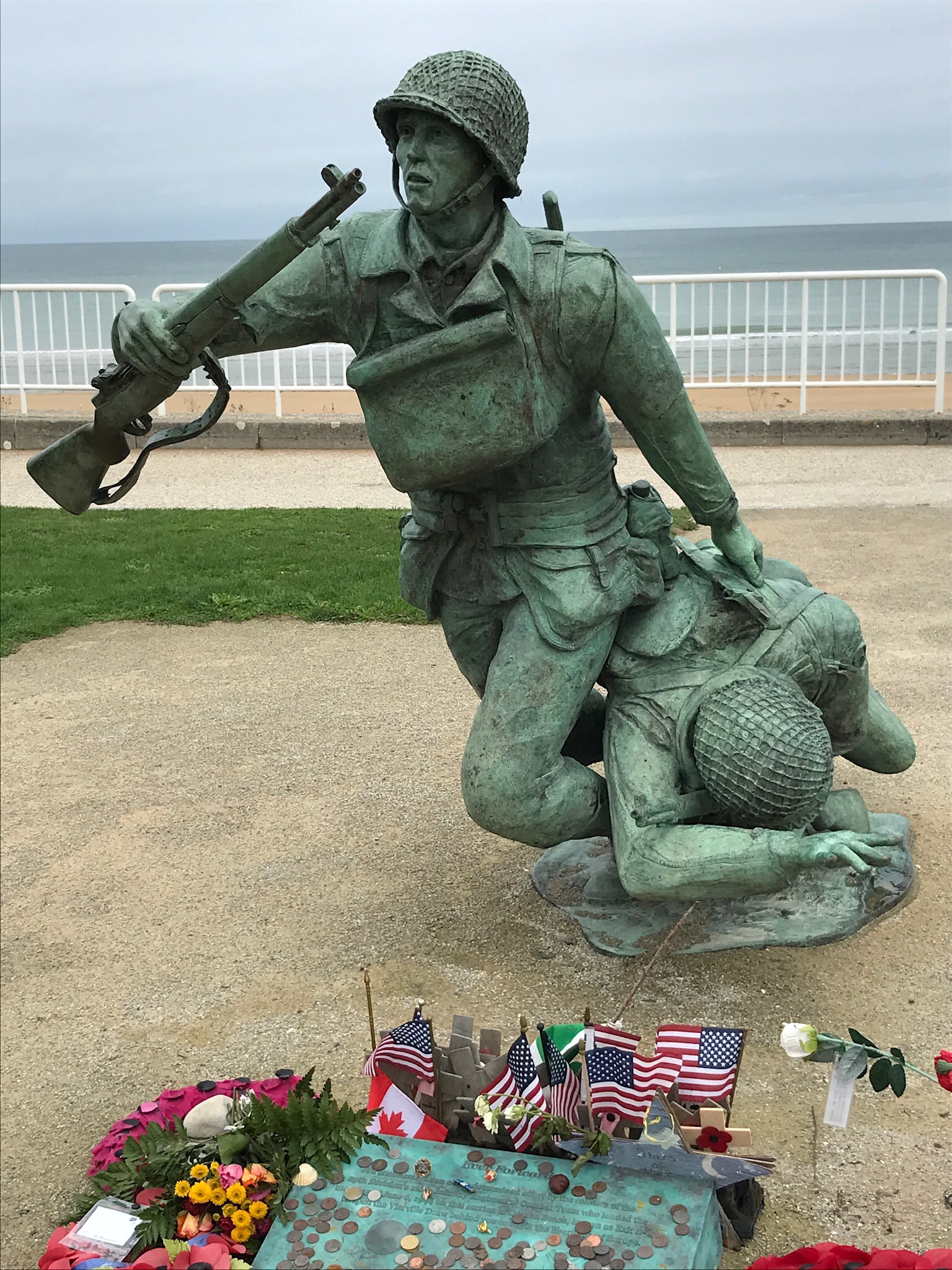
Omaha Beach
Listening to Beethoven’s Fifth Sympathy as background music for opening scenes of The Longest Day is an appropriate introduction to what will be a week of museums and sites which tell the story of the longest day in the memories of thousands of men who survived the invasion of Normandy. June 6th, 1944 – the day when Evil witnessed the biggest Armada the world has ever known.
Every human being should recognize the significance of June 6, 1944. D-Day = “The Day.” June 5 was D-1, June 7 was D+1. June 6, 1944 was D-Day, a day that changed the course of history.
The jut of land where our Allies landed and captured before turning north to overtake the German army and end the war some 15 months later, is small: just 100 miles or so east to west and perhaps 50 miles across. Yet it stands witness to some of the most unselfish acts of bravery one can imagine.
I will be lodging in the towns of Caen, Hermanville-sur-Mer, Bayeux, and Sainte-Mére-Èglise. From there I can spend my days exploring Normandy’s plethora of museums, battlefields, monuments and cemeteries.
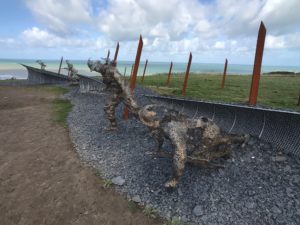
Arromanches-les-Bains and Gold Beach
Casualties can only be guessed. Historians are still calculating the death toll.
All these soldiers, men and women, were there to defend the honor and beliefs of their country: American, British, Canadians, Australians, South Africans, New Zealanders, Belgians, French, Greeks, Czechs, Norwegians, Poles, Dutch and German. Losses were grim. It is estimated that Allied casualties were somewhere around 10,000 with 4,500 killed. Americans accounted for some 2,500 of these fatalities. Figures are unknown, but roughly 200,000 German troops were killed or wounded. Civilians also paid a heavy price.
I divide my exploration into three distinct destinations: museums, batteries and cemeteries. Memorials dot each path.
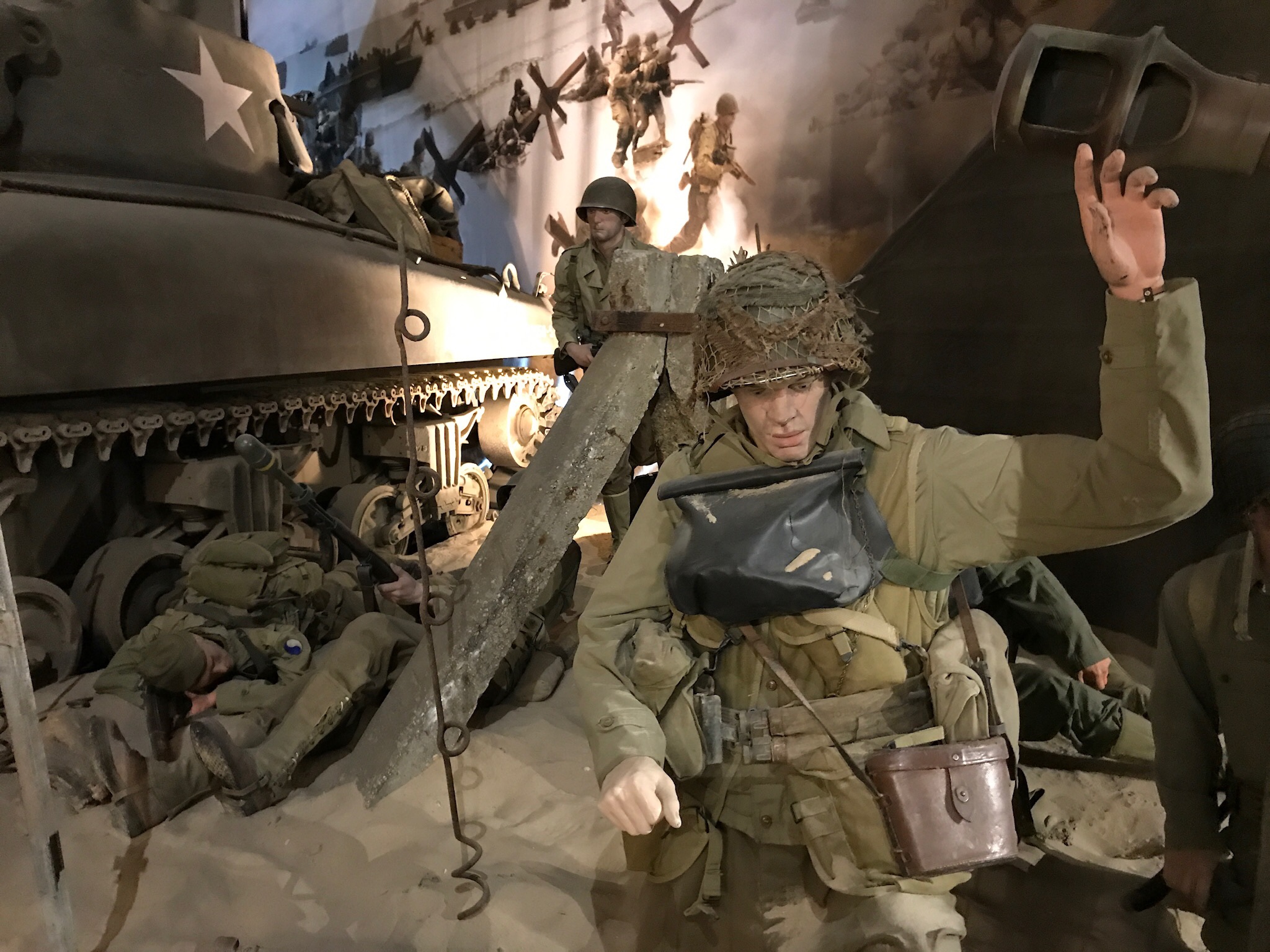
Overlord Museum at Omaha Beach
Museums are somewhat repetitive after a time. However, if told to pick just five, it would be impossible. Each of the five beach landing sites – Sword – Juno – Gold – Omaha – Utah – has a wonderful museum explaining that section of the invasion. Each has detailed displays, photos, news videos, personal testimonials, maps, memorabilia, dioramas, vehicles from tanks to planes, and personal collections containing a plethora of items gathered over a lifetime. Many videos of personal reflections can be watched. There is a short movie or two which explains the history of D-Day events and particularly how events occurred in that area. I would recommend visiting at least one museum in each of the five beach landing areas.
There are countless others. The museums attempt to bring their story of Normandy alive and most achieve that goal.
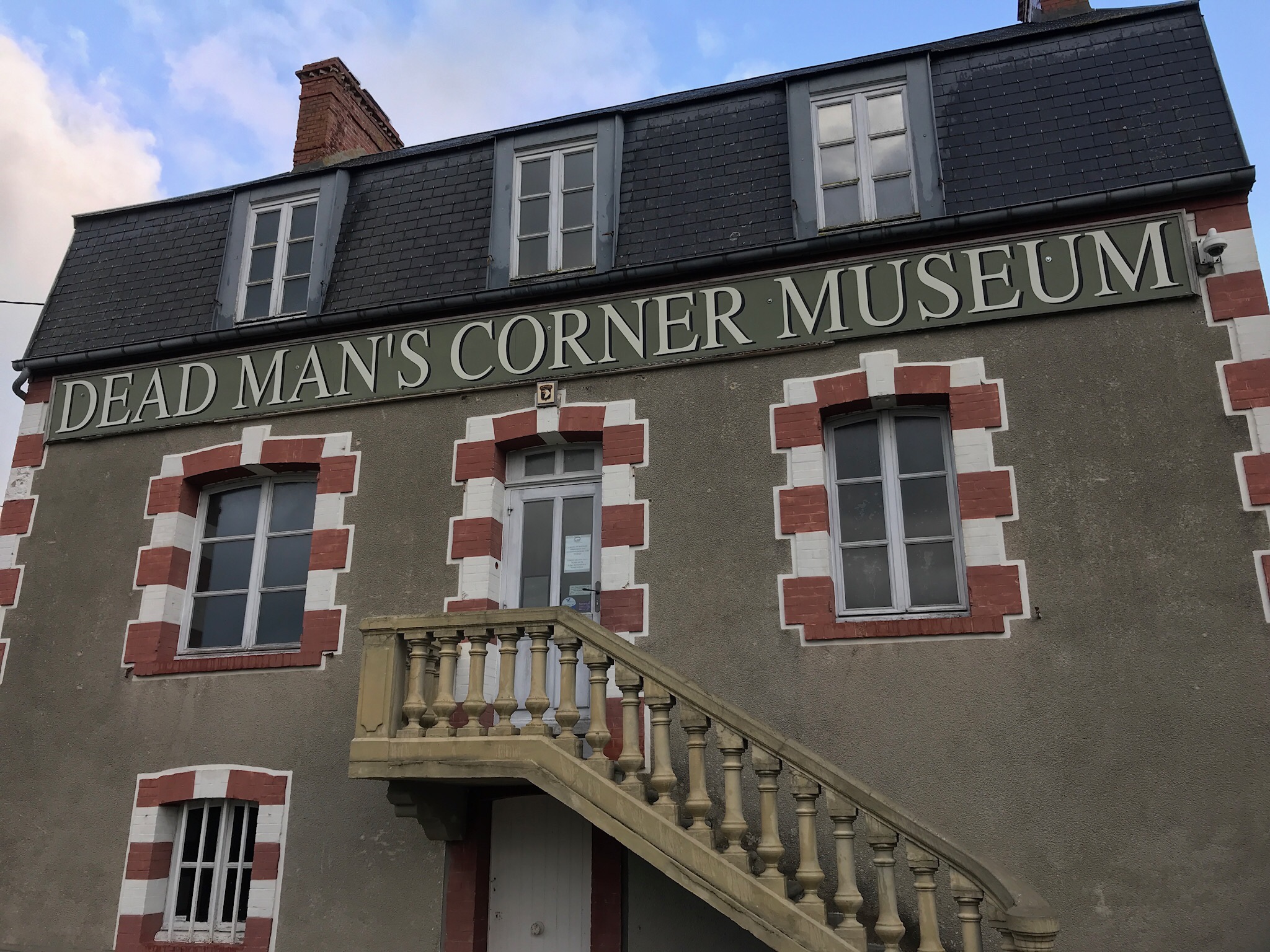
Museum at Dead Man’s Corner, Utah Beach
Throughout the area there are many privately owned museums. Most of them are worth a visit. Dead Man’s Corner Museum (Utah Beach) might be a little “campy” with its plane simulator, but the museum itself, the numbers of personal stories, and its movie is excellent. Quinéville’s World War 2 Museum (Utah) emphasizes the French, their suffering civilians, it’s army which continued to fight, and the resistance movement which played a vital role helping the Allies before and during the invasion of their homeland.
Arromanches-les-Bains’ Musée du Débarquement (Gold) should not be skipped. This museum explains the building of Mulberry Harbour and the American port on Omaha Beach which immediately followed invasion. These were extraordinary engineering feats!
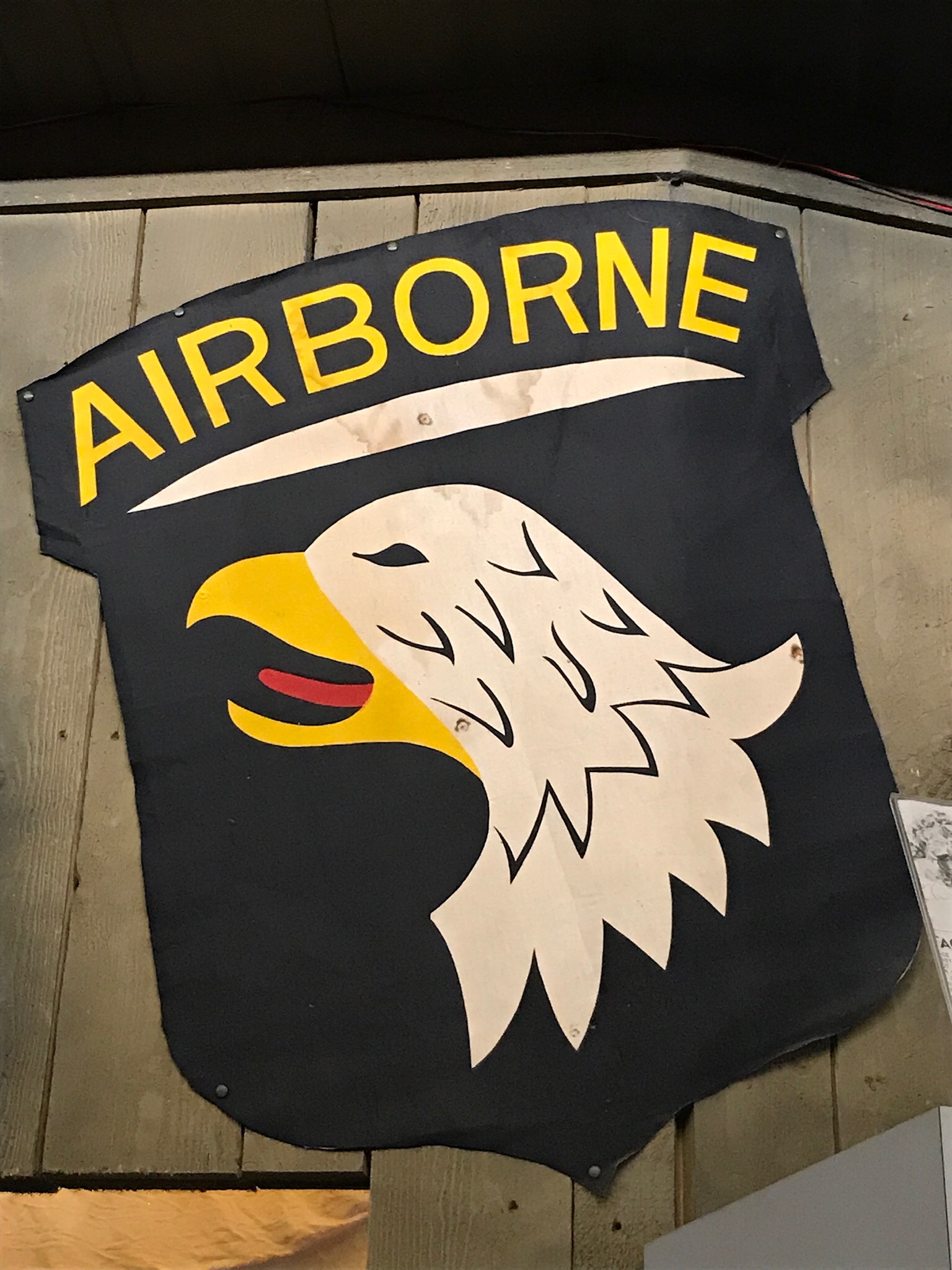
Screaming Eagles of 101st Airborne
The Airborne Museum in Sainte-Mère-Eglise is a fitting memorial to the 82nd and 101st paratroopers who were first to land on Normandy. They were to secure the bridges and roads preventing German support from reaching the beaches. The landings of paratroopers was followed by the Glider Infantry. Fighting was brutal and large numbers of paratroopers were shot down by the enemy; many gliders crashed on landing. There is also a movie highlighting President Reagan’s 1984 visit and inspiring D-Day speech, becoming the first U.S. president to visit Normandy marking the anniversary of allied forces invading occupied France.
Here, in Normandy, was the road to peace and freedom:
“Here, in this place where the West held together, let us make a vow to our dead. Let us show them by our actions that we understand what they died for. Let our actions say to them the words for which Matthew Ridgway listened: ‘I will not fail thee nor forsake thee’
Strengthened by their courage, heartened by their valor, and borne by their memory, let us continue to stand for the ideals for which they lived and died.” – President Ronald Reagan, Normandy June 1984

Omaha Beach
Monuments are everywhere honoring those who came and fought for Europe’s freedom. It is difficult not to stop, if only for a moment, to recognize each dedication: Memorial Pegasus and Horsa Bridge where British gliders landed in the dead of night to capture and hold this bridge as a part of Operation Deadstick; Monument to those who Perished at Sea; Monument Francais Libres, simple but meaningful sculpture; Churchill Tank; D-Day Memorial and The Queen’s Own Rifles of Canada; Cross of Lorraine; Omaha Beach Memorial; Memorial Parachutist – Iron Mike Memorial. No one is forgotten. No courageous deed has been ignored. The French remember!
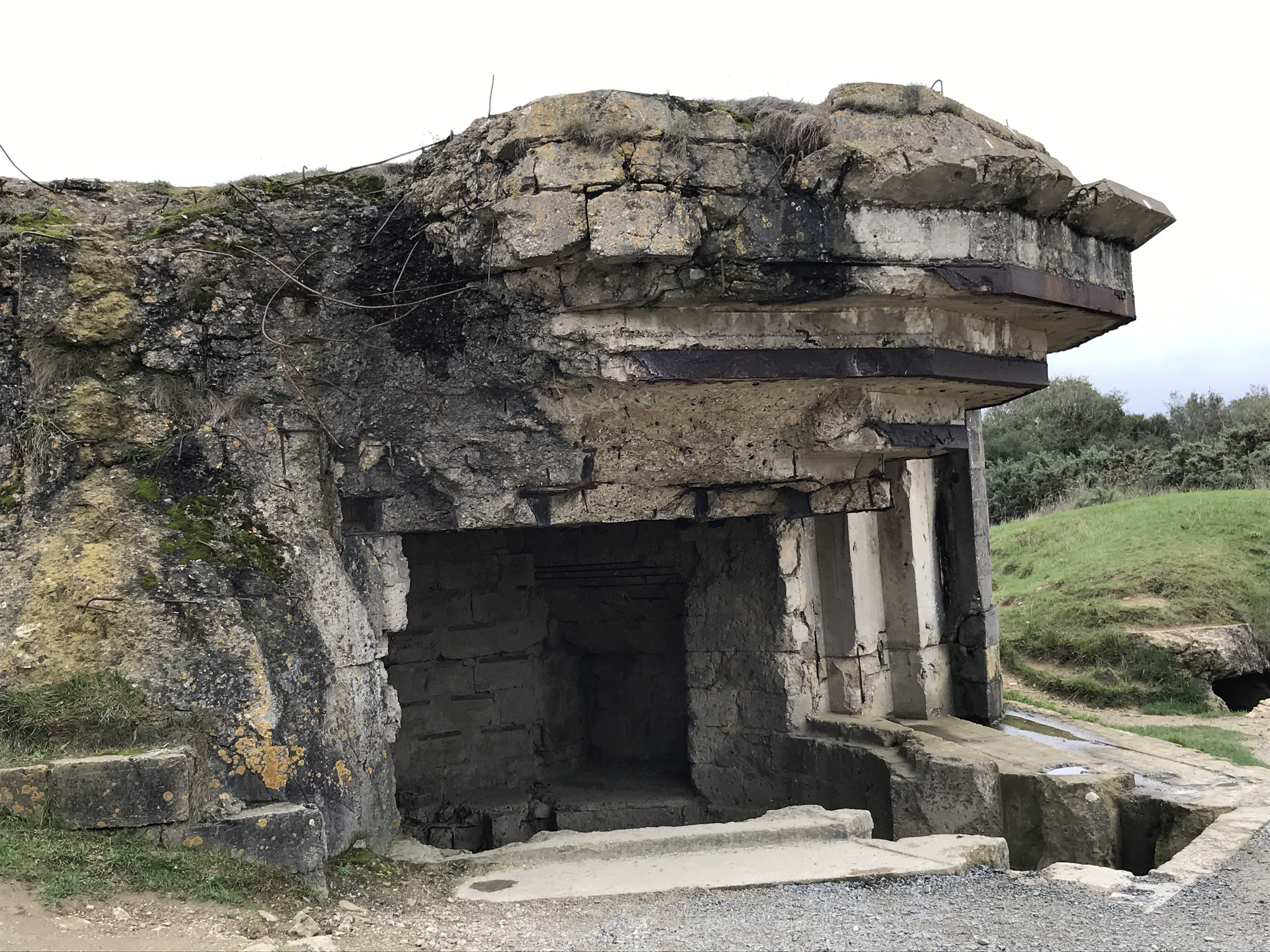
German batteries at Ponte du Hoc
The German batteries range from one big blockhouse to a large group of them like you will find at Crisbecq overlooking Utah Beach. When I say “overlooking” that can be a stretch because these massive batteries can be 5-10 miles inland and still have the fire power to protect the beaches. For Crisbecq and the ones at Maisy, they were able to cover Omaha and Utah beaches and environs at a deadly level. Bombing runs destroyed some batteries; for many the invasion forces had to attack them front-on at a high cost in casualties. This was especially true at Omaha Beach. These bunkers are massive, dug deep into the earth, well armed and were almost impregnable. There are several interesting batteries around which to roam. Certainly do not miss exploring those at Pointe du Hoc.
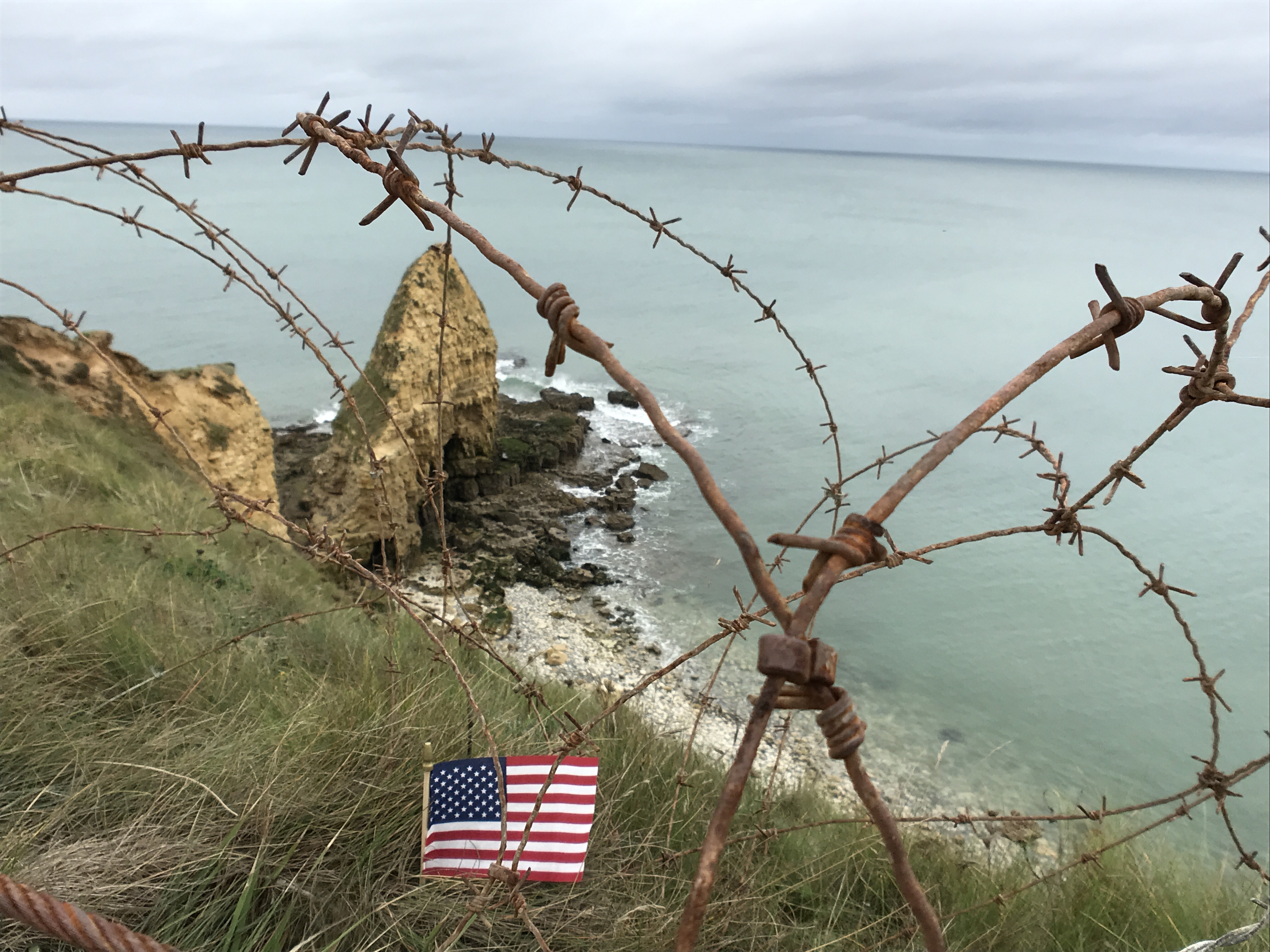
Cliffs of Pointe du Hoc
Batteries were just part of the massive defenses known as the “Atlantic Wall” which ran down the western coastline from Norway to the French border with Spain. Germans were dug in and prepared, especially atop the cliffs of Pointe du Hoc and along Omaha Beach. This landing was especially brutal and costly for the Americans. Bombing runs had failed to knock out most of the batteries. The carnage became so severe that U.S. Lieutenant General Omar Bradley considered stopping the entire operation.
At Juno, Germans fired from bunkers cutting down Canadian soldiers struggling with the rough seas. Allied aerial bombardments wiped out the bunkers along Gold Beach and cleared the way for the British troops. Bunkers and battery sites can be visited all along the coastline, including at Merville; Widerstandsnest 62; the huge Longues-sur-Mer battery German battery, guns still in place and making it clear what these troops faced when storming the beach. More batteries are at Pointe du Hoc and Maisy. The batteries and tunnels are open at Crisbecq and d’Azeville. The Germans had years to prepare and dig in; the Allies knocked them out in a few days.
You walk the sands of Juno, they walk with you.
Good God, the courage and determination of our soldiers as they rushed these cliffs, ignoring the cacophony of cannon and guns, stepping over their screaming fellow soldiers and friends to charge these German bastions.
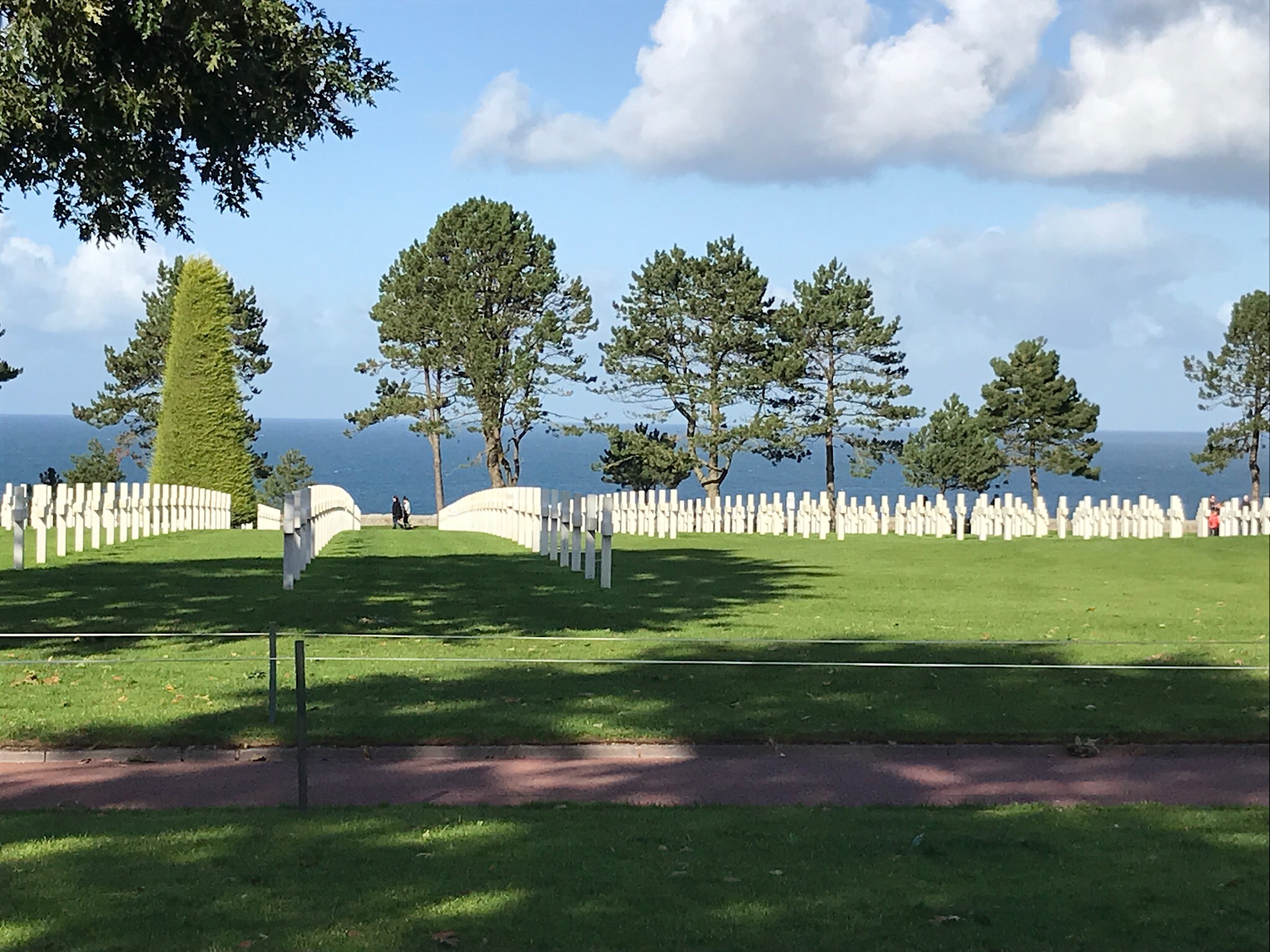
Normandy American Cemetery, Colleville-sur-Mer, overlooking Omaha Beach
Having explored battle sites and museums in northern France and Belgium, I expected, like on the Western Front, vast numbers of cemeteries. This was not the case. Because many American soldiers’ remains were repatriated, there are only a handful of cemeteries. The Americans had three temporary cemeteries, holding almost 13k servicemen, including the remains of General Theodore Roosevelt, around Sainte-Mère-Eglise. In 1948, these cemeteries were decommissioned and families were able to choose to repatriate their loved ones or to have them buried at the American Cemetery at Colleville-sur-Mer. (There were other temporary sites; the German Cemetery at La Cambe was originally an American Cemetery until remains were shipped home in 1947).
The Brittany American Cemetery is just on the border of Brittany and marks the point where American troops made their breakthrough from the hedgerow country of Normandy into the plains of Brittany during the offensive near Avranches. A great many of the 4,410 servicemen buried here died in the fighting in and around Saint-Lô.
For both American cemeteries, I have researched soldier’s names on Find A Grave, brought along several American flags, and taken photos to send to those who research their genealogies and seek photos of the final resting place for their ancestors. This brings my experience up close and personal.

German War Cemetery at La Cambe
The Canadian’s Bény Sur Mer Cimetière is inland from Juno Beach. A large British Commonwealth War Cemetery is in Bayeux just across the street from the Battle of Normandy Museum. There are two German cemeteries, La Cambe near Pointe du Hoc and the Pierrepont German Military Cemetery northwest of Sainte-Mère-Eglise in Orglandes.
As I walk the cemeteries of Normandy, there are several things that assault my senses. Primarily I think “they are all so young.” Secondly, parents, wives and children never celebrated their return. None of these young men ever went home again. I have had the privilege to visit the grave of my great-uncle who died fighting in Italy and is buried in the American Cemetery outside Florence. Many of these graves I walk among this week have never been visited by family. This knowledge is painful. The cemeteries are beautiful, well kept, and fitting honors to those buried here. But, these nation’s finest never came home.
There are many interesting churches with their distinctive square Norman towers that withstood the German invasion and Allied bombings. The most famous is that of Sainte-Mére-Èglise. It was on its steeple where the American John Steele of the 505 Parachute Infantry Regiment landed. He hung there for two hours, pretending to be dead, before he was taken prisoner by Germans. He later escaped to fight another day. The church, with a dummy hanging from its steeple, museum and Liberation Monument are open for visits.
I understand the Americans did not have to come to our fight.
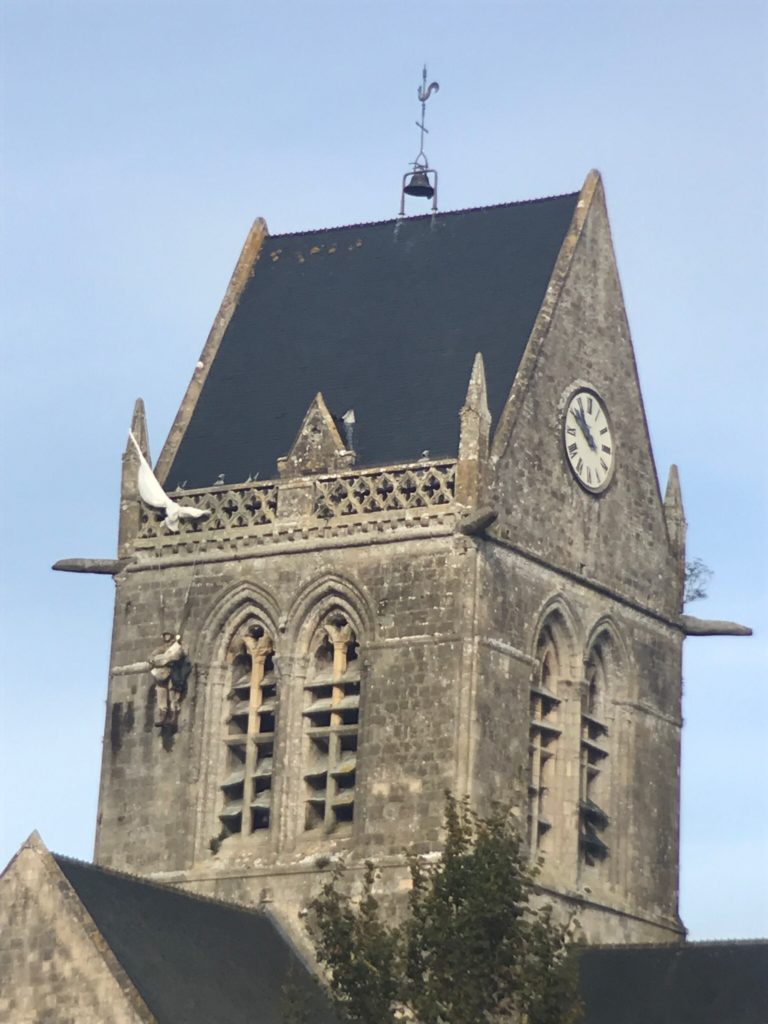
One must always remember – Sword, Juno, Gold, Omaha, Utah – but these beaches were just the beginning. The battle for Normandy would take another two months to complete through flooded fields, village to village, and among the thick hedgerows of vegetation. During 17 days of close fighting in marshes and hedgerows before capturing Saint-Lo, General Bradley lost 40k men to advance but 7 miles.
Allies battled at great cost of lives, both military and civilian (about 15,000 French civilians died), pushing the Germans from Sainte-Mère-Eglise, Cherbourg, Caen, Avranches and dozens of villages in between.
Over 150,000 men parachuted into or stormed the beaches of Normandy on D-Day; the British and Canadians put 75,215 troops ashore on three beachheads and the Americans stormed two beaches with 57,500, plus an additional 20,000 allied Airborne troops dropped inland to secure the access bridges. By D-Day +5, the Allies had landed 326,547 troops, 54,186 vehicles and 104,428 tons of supplies. By 4 July one million men had been landed.
By end of July, the peninsula was strengthened from Cherbourg to east af Saint-Lo with a final breakthrough at Avranches. Patton’s 3rd Army entered the foray and with his “kick him in the ass” philosophy his troops performed their own blitzkrieg and quickly routed the Germans who fled north. Patton turned his troops towards Paris and never looked back.
Visiting Normandy and absorbing its history is a life-changing experience. One can only imagine the fear, pain, sacrifice and bravery of the soldiers who stormed these beaches in the face of an implacable enemy. Every site, every memorial, every grave, every moment contemplating the beaches of Normandy should only cement ones resolve to never allow this to happen again.
Driving the roads of Normandy, squeezing through villages which experienced 4 years of Nazi domination and cruelty, seeing countless American flags and written signs of welcome and thanks, reading the monument dedications to the servicemen who stormed Normandy in 1944 is an experience I wish all people could experience. It changes one. It is clear: here in Normandy, the French have never forgotten and will forever be appreciative of their freedom bought at the expense of these selfless men.
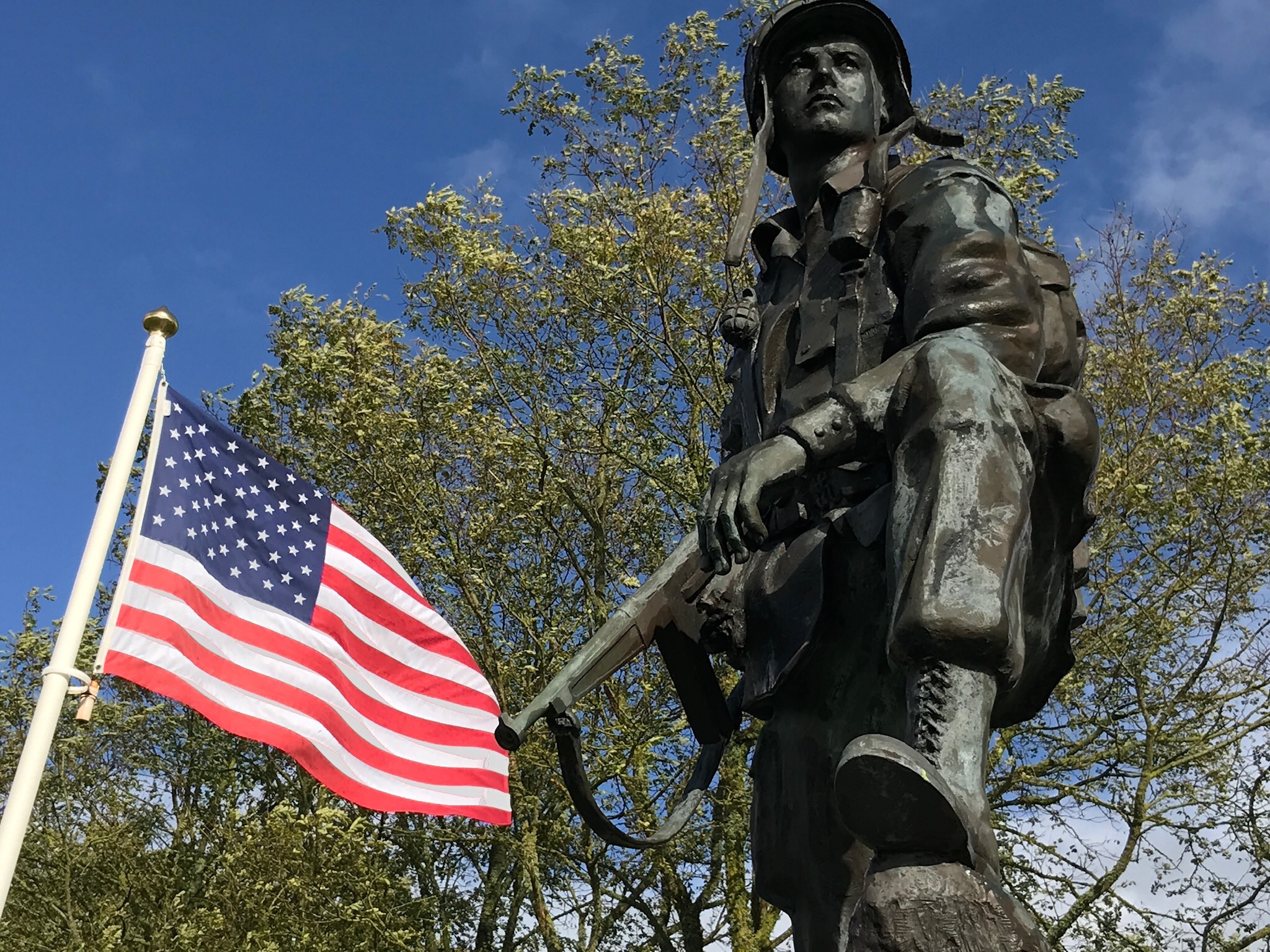
Iron Mike
Near Sainte-Mère-Eglise is the Iron Mike Memorial (a replica of The Airborne Trooper bronze at Ft. Bragg, home of the 82nd airborne). The bronze paratrooper overlooks the site of the battle for la Fière Bridgehead, where over 250 men lost their lives, 2 men awarded the Medal of Honor. I end my week of exploration beneath the determined, proud gaze of Iron Mike.
Today we live in peace, freedom and dignity because others gave their life for us.
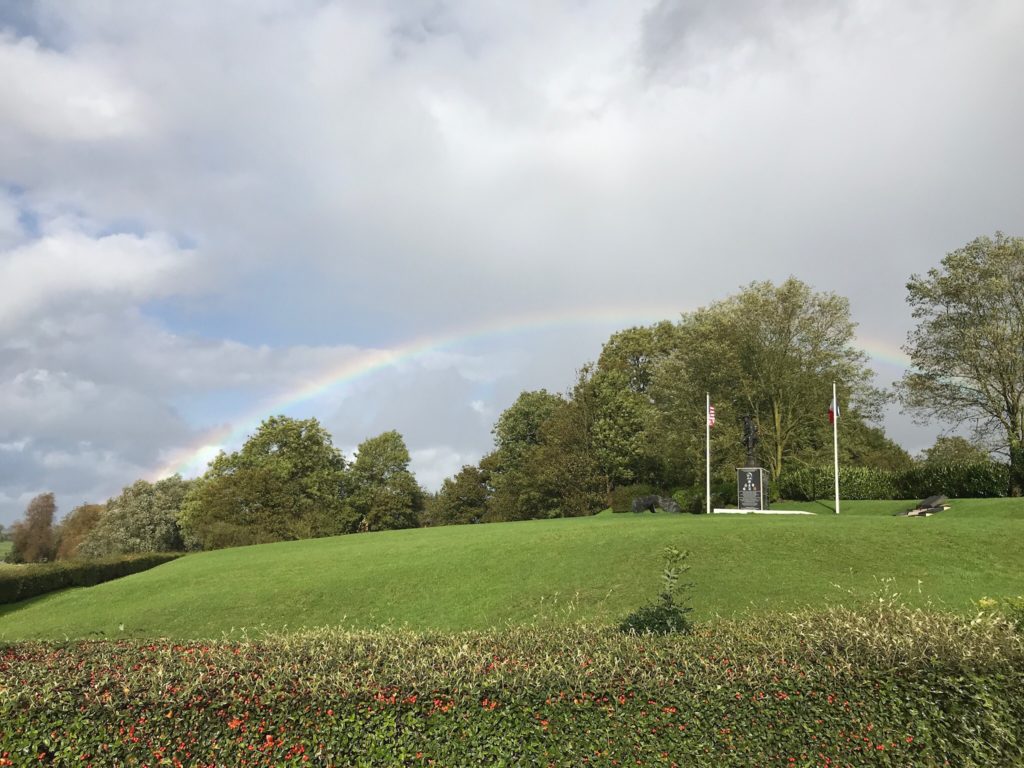
The rain has stopped, the sun is bright and surrounding fields are glistening green. A large rainbow arches in the western skies – all peaceful signs that such sacrifice was worth it.
Many men came here as soldiers
Many men will pass this way
Many men will count the hours
As they live the longest day.
Many men are tired and weary
Many men are here to stay
Many men won’t see the sunset
When it ends the longest day.
0 Comments